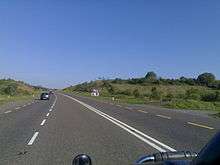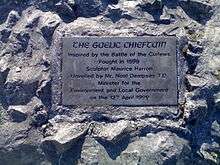Battle of Curlew Pass
| Battle of Curlew Pass | |||||||
|---|---|---|---|---|---|---|---|
| Part of the Nine Years' War | |||||||
 The 'Gaelic Chieftain' statue overlooks the N4 bypass, but is 2 kilometers north east of the battlefield. | |||||||
| |||||||
| Belligerents | |||||||
|
|
| ||||||
| Commanders and leaders | |||||||
|
Brian Óg O'Rourke Red Hugh O'Donnell | Sir Conyers Clifford † | ||||||
| Strength | |||||||
| 1,700 | ~2,000 | ||||||
| Casualties and losses | |||||||
| low | 500 killed | ||||||
The Battle of Curlew Pass was fought on the 15th of August 1599, during the campaign of the Earl of Essex in the Nine Years' War, between an English force under Sir Conyers Clifford and a rebel Irish force led by Aodh Ruadh Ó Domhnaill (Red Hugh O'Donnell). The English were ambushed and routed while marching through a pass in the Curlew Mountains, near the town of Boyle, in the west of Ireland. The English forces suffered heavy casualties. Losses by allied Irish forces were not recorded but were probably minimal.
Campaign
In April 1599, The 2nd Earl of Essex landed in Ireland with over 17,000 troops and cavalry to put down the rebellion of Hugh O'Neill, 3rd Earl of Tyrone, and Red Hugh O'Donnell, which had spread from Ulster to all of Ireland. To this end, he supported an Irish enemy of O'Donnell's, Sir Donogh O'Connor (O'Connor Sligo), encouraging him to repossess those territories of his in Sligo that O'Donnell had occupied.
Sligo Town was an excellent advance base, with Ballyshannon 20 miles to the north-east commanding an important river-ford at the principal western passage into O'Donnell's country in Ulster. English military advisers had long urged the government councils in Dublin and London to capture these strategic points.
O'Connor's brother-in-law, Tibbot na Long Burke (son of Gráinne O'Malley), was appointed joint-commander with an English captain of a force sailing from Galway, and O'Connor was expected to receive them in Sligo. However, O'Donnell quickly besieged O'Connor at Collooney Castle with over 2,000 men in an effort to starve him out, and Lord Essex was put on the back foot.
Essex had no option but to support the besieged O'Connor, one of the few Gaelic chieftains the Crown could rely upon for support. He ordered the experienced Sir Conyers Clifford, who was based in Athlone, to relieve the castle with 1,500 English infantry and 200 cavalry. It was hoped that the operation would also distract the chief rebel, Tyrone, and afford the Crown an opportunity to march into his Ulster territory across its south-eastern border.
O'Donnell left 300 men at Collooney Castle under his cousin, Niall Garbh O'Donnell, and sent another 600 to Sligo Town to prevent the landing of English reinforcements under Tibbot na Long. He then marched to Dunavaragh with 1,500 of his men, where he was joined by the additional forces of Brian Óg, King of West Breifne, who had 400 soldiers stationed at the pass, as well as those of Conor MacDermott. The Irish then carefully prepared an ambush site in the Curlew Mountains, along the English line of march. O'Donnell had trees felled and placed along the road to impede their progress. When he got word of the English passing through Boyle, O'Donnell positioned his men. Musketeers, archers and javelin men were placed in the woods alongside the road to harass the English. The main body of Irish infantry, armed with pikes and axes, were placed out of sight behind the ridge of the mountain.
The battle
In hot harvest weather, Clifford's force marched from Athlone through Roscommon, Tulsk and Boyle. At 4pm on August 15, they reached the foot of the Curlew Mountains (highest point 860 feet), which had to be crossed before Sligo could be approached. The expedition was poorly supplied, and Clifford's men were tired and hungry, and probably in no fit state to continue. But Clifford had received false intelligence that the pass was undefended, and he therefore chose to seize the opportunity and march across, promising his troops plenty of beef in the evening. This meant that his men missed out on the rest that had been planned for them in Boyle, whereas the Irish were well fed and prepared.
The English came under gunfire, arrow and javelin attack as soon as they reached the first of O'Donnell's barricades, between Boyle and Ballinafad. The barricade was immediately abandoned by the Irish but as the English moved past and proceeded up the hill they sustained further casualties. The road consisted of "stones of six or seven foot broad, lying above ground, with plashes of bog between them", and was lined with woodland on one side. The further the English advanced, the more intensive the rebels' fire became, and some English soldiers began to lose their nerve and slip away. Eventually, there was a firefight, lasting about 90 minutes, at the end of which the English vanguard had run out of gunpowder.
The commander of the vanguard, Alexander Radcliffe, could no longer control his troops. They wheeled about in a panic and collided with the main column, which broke and fled. The commander led a charge with his remaining pikemen but was shot dead. With the English ranks in disarray, the main body of Irish infantry, which had concealed itself on the reverse slope of the hill, closed in and fought hand to hand. Clifford tried to regain control over his men, but appeared overcome by his circumstances. He managed to rally himself and was killed by a pike-thrust as he rushed the enemy. The English were routed, but the situation was prevented from becoming a complete disaster for them when the commander of the horse, Sir Griffin Markham (with John Harington in his ranks), charged uphill - "amongst rocks and bogs where never horse was seen to charge before" - and temporarily drove the rebels back.
Though the actions of the English cavalry allowed many of their foot soldiers to escape, Clifford's men were pursued as far as the town of Boyle, where they found shelter in Boyle Abbey. About 500 English were killed in the battle. Irish losses were not recorded, but were probably small, having been firing from prepared positions and then routing a disorganised and demoralised enemy.
Aftermath


Brian Óg O'Rourke, who had led the soldiers on the ground, ordered Clifford's head to be cut off and delivered to O'Donnell - who had remained nearby, but without taking part in the fight.[1] While the head was brought to Collooney Castle to intimidate its defenders, the trunk was carried by MacDermott to the monastery of Lough Key, where he hoped to use it to ransom his own prisoners. At last, the trunk was given a decent burial in the monastery, and it was noted at the time that Clifford had lately dreamed of his own capture by O'Donnell and of being carried by monks into their convent.
O'Connor Sligo surrendered the castle shortly afterwards and reluctantly joined with the rebels. After the victory, there was a noticeable increase in the rate of desertion by Irish troops from the ranks of Essex's army, and the earl ordered that the surviving troops be divided up as fit only to hold walls. https://neverfeltbetter.wordpress.com/2012/12/11/irelands-wars-the-curlew-pass/ The battle was a classic Gaelic Irish ambush, similar to the battle of Glenmalure in 1580 or the battle of the Yellow Ford in 1598. According to the Annals of the Four Masters, the victory was put down to the intercession of the Blessed Mary, rather than to arms. But Clifford had been overconfident - a trait in him that Essex once warned against - and it is clear that English military commanders were choosing to learn the hard way about the increased effectiveness of Irish rebel forces.
The Queen's principal secretary, The Rt Hon. Robert Cecil, M.P., rated this defeat (and the simultaneous defeat of Harrington in Wicklow) as the two heaviest blows ever suffered by the English in Ireland, and sought to lay the blame indirectly on Lord Essex. It left O'Donnell and Lord Tyrone free from any threat from the Connacht side, and rendered a land-based attack through Armagh highly improbable, a factor that weighed with Essex as he marched northward later in the year and entered a truce with Lord Tyrone.
In August 1602, the Curlew Pass was the scene of the last victory won by the rebels during the war, when a panicking English force was again routed and suffered significant losses; this time, the rebels were led by Rory O'Donnell (and with him, O'Connor Sligo) who commanded 400 musketeers.
Today the battlefield at Curlew Pass is overlooked by an impressionistic sculpture by Maurice Harron called "The Gaelic Chieftain", unveiled in 1999.
References
Sources
- John McCavitt, The Flight of the Earls, Gill & Macmillan, Dublin 2002.
- Cyril Falls Elizabeth's Irish Wars (1950; reprint London, 1996). ISBN 0-09-477220-7.
- Cyril M. Mattimore, Account of the battle located here